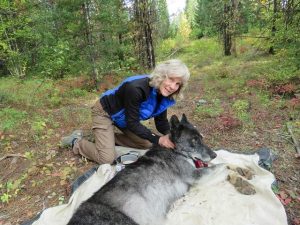
Our own Diane Boyd got some more ink, this time in a long-form article with lots of photos published in ‘Nautilus’…
Diane Boyd walked along the North Fork of the Flathead River. It was a clear blue summer day, and the wolf biologist relished being in this Rocky Mountain valley in northwestern Montana. She set foot here 45 years ago to track the first known gray wolf to wander into the western continental United States from Canada in decades. Humans had exterminated the last of them in the 1930s.
The river wove through pine, aspen, and willow trees that rose along the edge of a sprawling grass meadow. The mountain peaks in the distance were topped with snow. Boyd grew up in suburban Minnesota, where she was the neighborhood kid who could be found at the wild edges of the subdivision putting caterpillars in jars.
“I always wanted to go more and more wild in my life—wildlife, wild places—and it doesn’t get a lot wilder than here,” Boyd said to me last summer, as we walked through the quiet meadow.
At age 69, dressed in jeans, running shoes, and a T-shirt picturing a dog lazing on a lake pier, Boyd seemed very much the innately independent biologist who settled here at age 24. She spoke with a directness that had little room for sentimentality. The meadow area is called Moose City and was originally a 1910s homesteader ranch with six log cabins. Boyd lived alone in one of the tiny cabins without electricity or running water for 12 years.